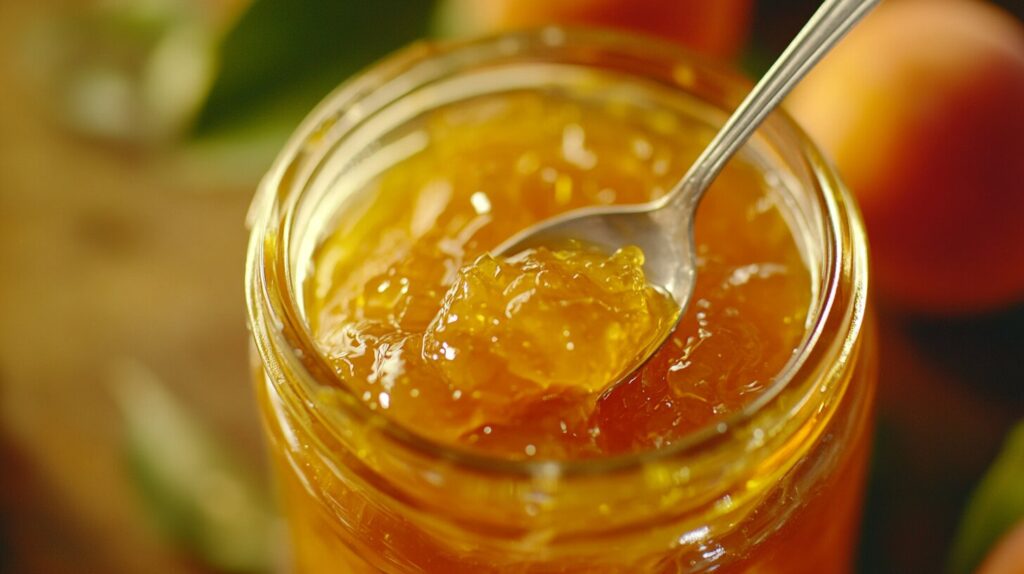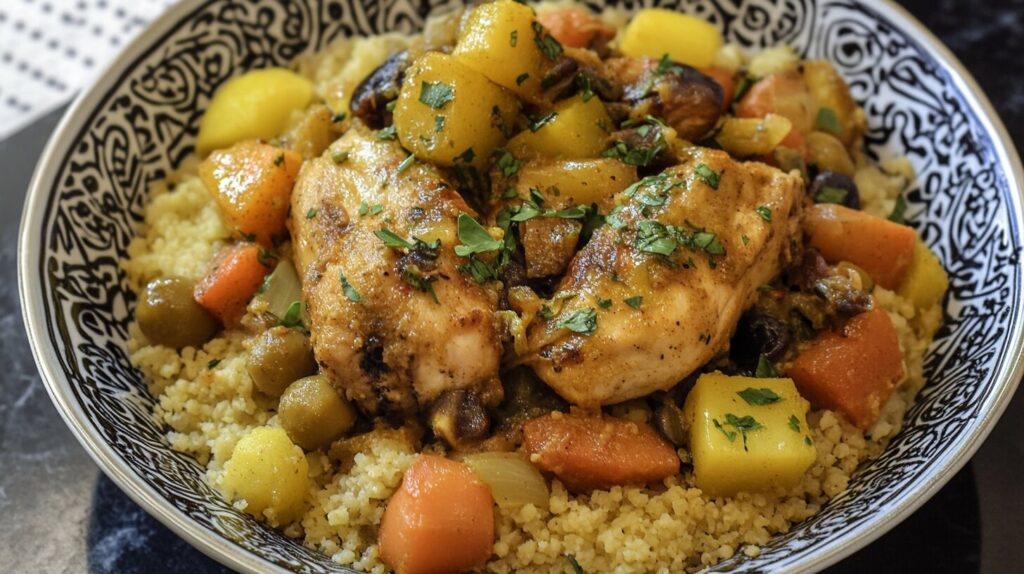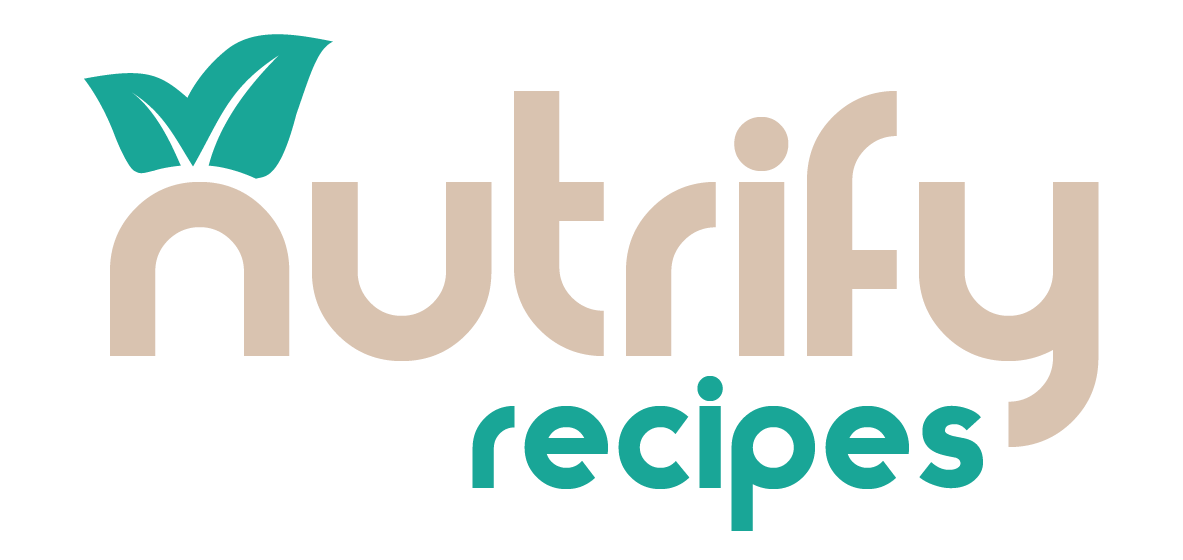Moroccan cuisine offers a delightful mix of bold flavors, rich scents, and a deep connection to cultural traditions. One of its most beloved dishes is Moroccan chicken couscous with apricot preserves, which beautifully captures the balance of sweet and savory that defines this cuisine. The dish features tender chicken, fluffy couscous, and the natural sweetness of apricots, coming together in a meal that is both delicious and meaningful.
If you’re preparing Moroccan chicken couscous with apricot preserves for a festive gathering or a simple family dinner, it’s a wonderful way to impress your guests. Thanks to its rich flavors and strong ties to tradition, this dish is an excellent way to bring a touch of Morocco to your table.
Table of contents
- The Role of Apricot Preserves in Moroccan Chicken Couscous
- Key Ingredients for Moroccan Chicken Couscous with Apricot Preserves
- Step-by-Step Guide to Making Moroccan Chicken Couscous with Apricot Preserves
- Tips for Perfecting Moroccan Chicken Couscous with Apricot Preserves
- Health Benefits of Moroccan Chicken Couscous with Apricot Preserves
- FAQs About Moroccan Chicken Couscous with Apricot Preserves
- Conclusion
The Role of Apricot Preserves in Moroccan Chicken Couscous
To achieve a perfect harmony of sweet and savory flavors, few ingredients stand out as much as apricot preserves. This key component lends depth and complexity to iconic Moroccan dishes like tagines, stews, and couscous.
A Sweet Tradition
Apricots have been a beloved part of Moroccan cuisine for centuries, thriving in the country’s warm climate and fertile lands. During the summer, fresh apricots take center stage, while dried apricots and preserves allow this cherished flavor to be enjoyed year-round.
Apricot preserves, in particular, are incredibly versatile. They can sweeten desserts, glaze meats, or enrich sauces with their unique sweetness. In Moroccan chicken couscous, the preserves serve as a flavorful highlight, enhancing the savory spices and tender chicken.
When cooked, the preserves create a subtle caramelization that deepens both texture and taste. This sweet element blends perfectly with earthy spices like cumin, turmeric, and cinnamon—core ingredients in Moroccan cooking.
Flavor Pairing
In Moroccan cuisine, the use of apricot preserves in savory dishes is a true testament to culinary creativity. These preserves act as a flavor bridge, seamlessly uniting the boldness of spices with the mildness of couscous.
For Moroccan chicken couscous, apricot preserves add a glossy finish and a delightful tang, leaving a subtle sweetness that lingers on the palate. The balance they bring to the dish highlights the genius of Morocco’s rich culinary traditions.
Health Benefits of Apricots
Beyond their exceptional flavor, apricots also offer numerous health benefits, making them a nutritious addition to your meals.
- Vitamin A: Supports eye health and promotes glowing skin.
- Fiber: Aids digestion and enhances satiety, keeping you full longer.
- Antioxidants: Protects against inflammation and lowers the risk of chronic diseases.
- By including apricot preserves in Moroccan dishes, you’re not only enhancing flavor but also adding a wholesome boost to your diet.
A Modern Twist
Traditionally, apricot preserves were made from fresh apricots and sugar, a process that required time and care. Today, high-quality store-bought options provide a convenient alternative for modern cooks.
When selecting apricot preserves, opt for those with minimal added sugars and natural ingredients. This ensures that your dish retains its authentic flavor and wholesome goodness.

Key Ingredients for Moroccan Chicken Couscous with Apricot Preserves
Creating an authentic Moroccan chicken couscous with apricot preserves truly begins with selecting the right ingredients. Indeed, each component plays a vital role in achieving the perfect balance of flavors and textures that beautifully define this dish. To help you get started, here’s a breakdown of the essential elements you’ll need:
The Base: Couscous
Couscous is the foundation of this dish. Look for high-quality semolina couscous to ensure light and fluffy grains. Traditional Moroccan couscous is typically steamed rather than boiled, which enhances its texture and flavor.
- Recommended type: Fine-grain couscous for a delicate texture.
- Tip: Rinse and steam the couscous twice for the best results, fluffing it with a fork between each steaming.
The Protein: Chicken
Chicken is the protein of choice for this dish, offering a tender and flavorful addition to the couscous. Bone-in, skin-on pieces such as thighs or drumsticks are ideal for creating a rich, savory broth.
- Seasoning: Marinate the chicken with Moroccan spices like cumin, turmeric, and paprika to infuse it with flavor.
- Cooking method: Sear the chicken first to lock in juices, then braise it gently in a spiced sauce.
The Sweetness: Apricot Preserves
Apricot preserves are the star ingredient that gives this dish its unique twist. They add a subtle sweetness that enhances the savory flavors of the chicken and spices.
- Quality check: Choose preserves with natural ingredients and minimal added sugar for an authentic taste.
- Quantity: Use about 3 tablespoons to achieve a balanced flavor without overpowering the dish.
Aromatic Spices
Moroccan cuisine is defined by its intricate use of spices. This recipe relies on a blend of warming and earthy spices to create depth and complexity.
- Key spices:
- Cumin: Adds earthiness and warmth.
- Turmeric: Provides a vibrant golden color and mild flavor.
- Cinnamon: Balances the savory and sweet components.
- Paprika: Offers mild heat and smoky undertones.
- Additional herbs: Fresh cilantro and parsley for garnish.
Vegetables
Vegetables add color, texture, and nutritional value to the dish. Commonly used options include:
- Carrots and zucchini: Provide sweetness and crunch.
- Onions: Enhance the flavor base of the sauce.
- Chickpeas: Add protein and a creamy texture.
Liquid Components
- Chicken stock or water: Creates a flavorful broth for braising the chicken.
- Olive oil: Used for sautéing and enhancing the couscous’s flavor.
Optional Additions
To customize the dish, consider incorporating:
- Dried fruits: Raisins or prunes for extra sweetness.
- Nuts: Toasted almonds or pine nuts for crunch and richness.
- Harissa: A dollop of this spicy paste for those who enjoy a kick of heat.

Ingredient Summary
Here’s a quick shopping list for easy reference:
- Couscous
- Chicken (thighs or drumsticks)
- Apricot preserves
- Spices: cumin, turmeric, cinnamon, paprika
- Vegetables: carrots, zucchini, onions, chickpeas
- Chicken stock or water
- Olive oil
- Fresh cilantro and parsley (for garnish)
Step-by-Step Guide to Making Moroccan Chicken Couscous with Apricot Preserves
Creating Moroccan chicken couscous with apricot preserves is a rewarding culinary journey. This guide will walk you through each step, from steaming couscous to crafting the apricot-glazed chicken, resulting in an authentic and mouthwatering dish.
1. Steaming the Couscous
Rinse the Couscous
- Place the couscous in a large bowl and rinse it under cold water.
- Drain thoroughly to remove excess moisture.
First Steaming
- Spread the couscous in the top part of a couscoussier (traditional steamer) or a fine mesh steamer basket.
- Steam it over boiling water for 15–20 minutes.
Fluff the Grains
- Transfer the couscous to a large tray or bowl and fluff it with a fork.
- Add a drizzle of olive oil and a pinch of salt to enhance the flavor.
Second Steaming
- Return the couscous to the steamer for another 10–15 minutes until it’s soft, light, and perfectly cooked.
2. Marinating the Chicken
Prepare the Marinade
- In a small bowl, mix together 1 teaspoon each of cumin, turmeric, paprika, and salt.
- Add a pinch of cinnamon to bring a hint of sweetness to the blend.
Season the Chicken
- Rub the chicken pieces generously with the spice mixture, ensuring even coverage.
- Allow the chicken to marinate for at least 30 minutes to absorb the flavors fully.
3. Cooking the Chicken
Sear the Chicken
- Heat 2 tablespoons of olive oil in a large pot or tagine over medium heat.
- Add the marinated chicken pieces and sear until golden brown on all sides. Set aside.
Sauté the Vegetables
- In the same pot, add sliced onions and sauté until soft and translucent.
- Add diced carrots, zucchini, and a handful of chickpeas, stirring well.
Build the Sauce
- Pour in 2 cups of chicken stock or water.
- Stir in 2 tablespoons of apricot preserves and 1 teaspoon of cinnamon.
- Adjust seasoning with salt and pepper to taste.
Simmer the Chicken
- Return the seared chicken to the pot.
- Cover and let it simmer on low heat for 30–40 minutes, allowing the flavors to meld and the chicken to become tender.
4. Incorporating the Apricot Preserves
Enhance the Sauce
- During the last 10 minutes of cooking, stir in 1 more tablespoon of apricot preserves for added richness and a glossy finish.
Adjust the Consistency
- If the sauce is too thick, add a splash of chicken stock.
- If it’s too thin, simmer uncovered for a few minutes to reduce it to your desired consistency.
5. Assembling the Dish
Layer the Couscous
- Spread the steamed couscous evenly on a large serving platter.
Top with Chicken
- Arrange the cooked chicken pieces over the couscous.
Drizzle with Sauce
- Pour the apricot-infused sauce and cooked vegetables over the chicken and couscous.
Garnish
- Sprinkle freshly chopped cilantro and parsley on top for a burst of color and flavor.
- For extra flair, add toasted almonds or a handful of raisins.
6. Serving
Present Family-Style
- Moroccan chicken couscous is traditionally served on a communal platter.
- Place it in the center of the table and invite everyone to dig in.
Pair with Accompaniments
- Serve alongside Moroccan mint tea or a refreshing cucumber salad for a complete Moroccan dining experience.

Tips for Perfecting Moroccan Chicken Couscous with Apricot Preserves
Creating the perfect Moroccan chicken couscous with apricot preserves is easier than you might think. With some attention to detail and a few expert tips, you’ll soon be serving a dish that’s both authentic and packed with flavor.
Selecting High-Quality Ingredients
Couscous
First, it’s important to choose the right couscous. For the best results, go with fine-grain semolina couscous because it creates a light and fluffy texture. Try to avoid instant couscous since it doesn’t offer the same authentic experience.
Pro Tip: If you can, buy couscous from a Middle Eastern or North African store to get the most traditional flavor.
Chicken
Next, opt for bone-in, skin-on chicken pieces like thighs or drumsticks. These cuts add more flavor to the dish. If you prefer boneless chicken, it will work, but it may not deliver the same depth of taste.
Apricot Preserves
For the apricot preserves, it’s best to look for options made with natural ingredients and minimal sugar. If you have the time, homemade apricot jam is an excellent way to take the dish to the next level.
Perfecting the Couscous
Steaming Is Key
Traditional Moroccan couscous is always steamed, and this step is critical for achieving the ideal texture. If you don’t have a couscoussier (a Moroccan steamer), you can use a fine-mesh steamer or even improvise with a colander over a pot of boiling water.
Fluff Regularly
After each steaming, be sure to fluff the couscous with a fork. Adding a drizzle of olive oil and a pinch of salt helps to separate the grains and enhances their flavor.
Hydrate Properly
It’s also important not to over-saturate the couscous. Lightly dampen the grains before the first steaming so that they cook evenly.
Balancing Sweet and Savory
Apricot Preserves
Start with a small amount of preserves and adjust to taste as you cook. Adding too much sweetness early on can overpower the dish, so it’s better to add a little at a time.
Spices
Cinnamon and paprika bring warmth and depth, which pair beautifully with the apricots. At the same time, balance these with savory spices like cumin and turmeric to prevent the dish from leaning too sweet.
Vegetables and Chickpeas
Including carrots and chickpeas in the recipe adds natural sweetness and creaminess, providing a wonderful contrast to the other textures and flavors.
Achieving the Perfect Sauce
Consistency Matters
The sauce should be thick enough to coat the chicken, but not so thick that it clumps. If it’s too runny, simmer uncovered for a few minutes to reduce it.
Layering Flavors
To build depth, add apricot preserves in two stages—once during cooking and again near the end. This creates a rich and balanced flavor.
Brighten with Citrus
Before serving, add a squeeze of lemon juice to brighten the dish and cut through any excess sweetness.
Plating and Presentation
Layer for Visual Appeal
Start by spreading the couscous as a base on a large serving platter. Arrange the chicken pieces on top, then drizzle the sauce over everything for a glossy, mouthwatering finish.
Garnish Thoughtfully
Sprinkle fresh herbs like cilantro or parsley over the dish. To add extra texture and flavor, include toasted almonds or a handful of raisins.
Use a Large Platter
Traditionally, Moroccan chicken couscous is served on a communal platter. Place it in the center of the table to emphasize the spirit of sharing.
Troubleshooting Common Issues
Dry Couscous
If your couscous feels dry or clumpy, lightly sprinkle it with warm water and steam it for another 5–10 minutes.
Overcooked Chicken
To avoid drying out the chicken, keep an eye on it during braising. Aim for meat that’s tender and juicy, pulling easily away from the bone.
Unbalanced Flavors
If the dish turns out too sweet, add a pinch of salt or a splash of vinegar to balance it. For a more savory profile, increase the cumin or paprika.
Cooking Tools to Use
Couscoussier (Preferred)
This traditional Moroccan steamer is ideal for achieving the authentic texture of couscous.
Dutch Oven or Tagine
Both are excellent options for braising the chicken and developing rich, deep flavors.
Fine-Mesh Sieve or Colander
If you don’t have a couscoussier, these tools work well as substitutes for steaming couscous.
Health Benefits of Moroccan Chicken Couscous with Apricot Preserves
Moroccan Chicken Couscous with Apricot Preserves: A Nutritious Delight
This dish isn’t just bursting with flavor—it’s also packed with nutrients that contribute to a healthy and balanced meal. From energy-boosting grains to vitamin-rich vegetables, every ingredient plays a role in nourishing your body.
Nutritional Value of Couscous
Couscous, a staple in Moroccan cuisine, forms the heart of this dish. Made from semolina wheat, it’s not just delicious but also a smart, nutritious choice.
1. Rich in Complex Carbohydrates
Couscous offers sustained energy, making it a fantastic choice for active lifestyles. It keeps you energized and ready to tackle the day.
2. Naturally Low in Fat
This grain is naturally low in fat, supporting heart health and keeping calorie counts in check.
3. Packed with Selenium
Selenium, an essential mineral found in couscous, acts as a powerful antioxidant. It strengthens the immune system and protects against cell damage.
Protein Power from Chicken
Chicken is a key ingredient in this dish, offering lean protein to support muscle health and overall wellness.
1. High-Quality Protein
Chicken provides essential amino acids that help repair and build tissues.
2. Rich in B Vitamins
B vitamins like B6 in chicken aid in energy production and support brain function.
3. Low in Saturated Fat
When cooked skinless, chicken is a heart-healthy protein option, ideal for maintaining a balanced diet.
The Sweet Benefits of Apricots
Apricot preserves bring a delightful sweetness while delivering impressive health benefits.
1. Rich in Antioxidants
Apricots contain beta-carotene and vitamins A and C, which fight oxidative stress and promote healthy skin.
2. Supports Digestion
The natural fiber in apricots ensures a healthy digestive system.
3. Boosts Immunity
Loaded with nutrients like vitamin C, apricots enhance immune function and overall health.
Vegetables for Vitality
The addition of vibrant vegetables like carrots, zucchini, and chickpeas transforms this dish into a nutrient-packed meal.
Carrots
Carrots are rich in vitamin A, essential for eye health and a strong immune system.
Zucchini
Low in calories but high in water content and nutrients, zucchini aids digestion and hydration.
Chickpeas
These legumes are packed with plant-based protein and fiber, keeping you full and supporting muscle repair.
Balanced Spices for Wellness
Moroccan spices add layers of flavor while offering numerous health benefits.
1. Turmeric
Renowned for its anti-inflammatory properties, turmeric can help reduce the risk of chronic diseases.
2. Cinnamon
This warming spice helps regulate blood sugar levels while adding a comforting sweetness.
3. Cumin
Rich in iron, cumin supports energy production and aids digestion.
A Perfectly Balanced Meal
This dish combines all the elements of a wholesome meal:
- Carbohydrates: Couscous provides long-lasting energy.
- Protein: Chicken and chickpeas help with muscle repair and satiety.
- Healthy Fats: Olive oil supports heart health.
- Vitamins and Minerals: Vegetables and apricots boost overall wellness.
Portion Control and Customization
Portion Size
A standard serving strikes the perfect balance between satisfaction and calorie control.
Customization Options
- Adjust the sweetness by using more or less apricot preserves.
- Increase or decrease the vegetables and chicken based on your dietary needs.
Perfect for Special Diets
Low-Fat Option
Use skinless chicken and limit olive oil to make the dish even lighter.
Gluten-Free Alternative
Swap traditional couscous for gluten-free options like quinoa or millet.
Vegetarian Version
Replace chicken with additional vegetables or boost the chickpeas for more plant-based protein.
FAQs About Moroccan Chicken Couscous with Apricot Preserves
Q1: Can I use instant couscous for this recipe?
Yes, instant couscous can be used as a quick alternative. That said, for an authentic texture and flavor, traditional steamed couscous is highly recommended.
Q2: What can I use instead of apricot preserves?
If you don’t have apricot preserves on hand, you can substitute them with peach preserves, fig jam, or a mix of honey and dried apricots. These alternatives work well to maintain the sweet and savory balance of the dish.
Q3: Can I make this dish vegetarian?
Absolutely! You can replace the chicken with hearty vegetables like eggplant, pumpkin, or cauliflower. In addition, increasing the chickpeas provides additional protein and texture.
Q4: How can I store leftovers?
To store leftovers, be sure to separate the couscous and chicken into airtight containers. Keep them in the refrigerator for up to 3 days. When reheating, do so gently on the stovetop or in the microwave, adding a splash of water to maintain moisture.
Q5: Is this dish spicy?
Not at all! This dish is mildly spiced with warming flavors rather than heat. However, if you prefer it spicier, try adding harissa or chili flakes to the sauce.
Q6: What are some traditional sides to serve with this dish?
Popular sides include Moroccan mint tea, which pairs beautifully with the flavors, a refreshing cucumber and tomato salad, or crusty bread for scooping up the delicious sauce.
Conclusion
Moroccan chicken couscous with apricot preserves is a dish that beautifully blends tradition with a touch of sweetness. With each bite, the perfectly fluffy couscous and tender chicken, wrapped in a fragrant apricot-infused sauce, showcase the artistry of Moroccan cooking.
Whether you’re preparing it for a festive celebration or a warm family dinner, this dish never fails to impress. Its vibrant flavors and rich cultural roots make it a standout addition to any table. So, dive into the joy of creating this timeless classic, and be sure to share the experience with your loved ones—it’s the true spirit of Moroccan hospitality!
You may also like
If you’re a fan of bold flavors, check out How to Make a Smoky Chipotle Steak for a perfect dinner idea. Pair it with San Antonio Grilled Mexican Chicken Marinade or serve it alongside The Best Sides for Baked Beans.

